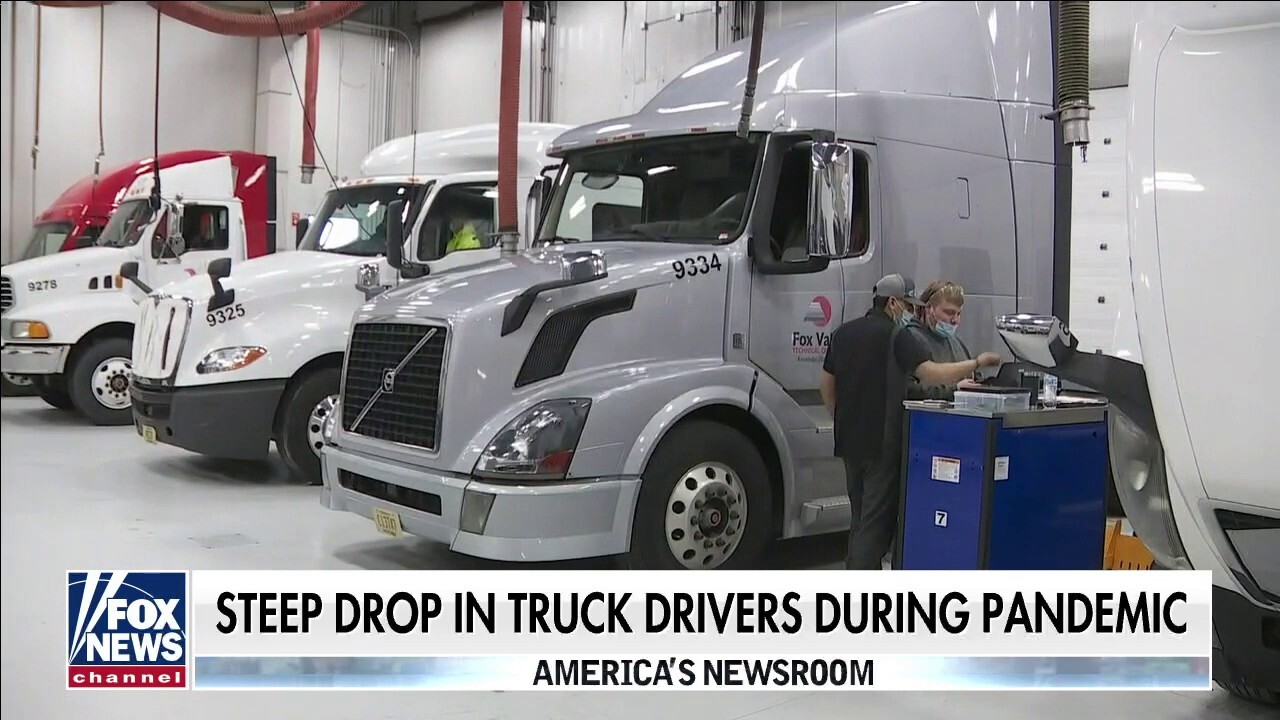Supply chain issues, aging workforce lead trucking industry to recruit younger drivers
Truck driver shortage blamed on variety of factors
Advocates, educators and employers work to bring diversity and youth into aging trucking industry
Jonathan Hunt fronts a Fox News package that interviews people across the cargo transportation industry to see how they're dealing with a shortage of drivers and an aging population of employees.
The backbone of America’s supply chain, the trucking industry, is struggling to replace an aging workforce.
The American Trucking Association (ATA) estimates that the industry has a shortfall of nearly 80,000 drivers, a number that’s only expected to grow in coming years unless employment trends change. With the necessity of the industry thrown into stark relief due to pandemic-related supply chain issues, shoring up employment in trucking has become a priority for groups across the country.
The trucker protests in Canada, and planned protests potentially taking place in the U.S., have demonstrated the importance of trucking in keeping the supply chain running and getting deliveries to people and businesses coast to coast.
The ATA report cited myriad factors in the driver shortage: an aging driver population, a lack of gender diversity, laws that keep drivers crossing state lines until they’re 21 years old and the time away from home required for long-haul trucking.
"I would say there's a shortage of people willing to do this job. There's a shortage of people who don't want to be away from home," Ellen Voie, the founder of Women in Trucking, told Fox News. "If we would treat drivers with respect and pay them for what they're worth and for all the time, I think we could alleviate a lot of the concerns that we have about keeping good drivers that we don't want to lose."
"I would say there's a shortage of people willing to do this job. There's a shortage of people who don't want to be away from home."
Attempts to meet the industry’s challenges are ongoing at every level across the country. Organizations and lawmakers are centering three priorities they think will pay dividends: advocating for diversity and youth, proactively introducing education to younger people, and changing policies that constrict young drivers in the industry.
One area of growth over the past couple of years is in wages. Most agree that truckers make more now than they did in the past, though the Bureau of Labor Statistics reported the median annual wage has hovered at just over $47,000.
Canadian truckers hold the line despite Trudeau invoking emergency powers
The Freedom Convoy is digging in. FOX Business’ Grady Trimble reports from Ottawa, Ontario.
Voie, a longtime executive and advocate in trucking, founded Women in Trucking five years ago with the intention to expand the employment of women. Her efforts, which began when she was working to retain nontraditional employees for a large Midwest carrier, have found marked success.
"When I started Women in Trucking, we were about 3% female drivers, and now we're at 10%," Voie told Fox News. "A more diverse and inclusive trucking industry would have a lot more women. Women make up 47% of the workforce and have half the population, so there's no reason why women can't make up half the driving force."
Beyond advocating for the hiring for women, WIT works with youth organizations to introduce the viability of careers in cargo transportation to girls. Notably, Voie said she worked with the Girl Scouts of America to create a trucking patch. To date, more than 1,600 Girl Scouts have earned the trucking badge, according to WIT.
Inexperience inevitably accompanies youth, and this dynamic holds in the trucking industry. As younger drivers take to the roads, some industry veterans are wary of the mistakes that may come their way.
"I've been out here 20 plus years, and I still learn something new every day…"
"My opinion is they're not getting the training that they really need," Carmen Anderson, a veteran long-haul truck driver, told Fox News. "They need to be with experienced people. Some of these mega carriers are, you know, training these people, and then six months later, they have somebody else training. … I mean, I've been out here 20-plus years, and I still learn something new every day on that."
USED CAR PRICES HAVE BEEN SURGING IN 2022
Anderson has been behind the wheel of a big rig for decades. She’s seen the job evolve from one that didn’t consider the needs of women drivers to one where equitable facilities and gender considerations are the new standard. The days when Anderson would have to ask a male driver to guard the door while she showered at a rest stop have been long gone.
Beyond the quality of truck stops and the generally heightened working conditions, Anderson said she’s also noticed changes in driver dynamics and solidarity. The decline in mentorship, in particular, worries her. She tries to be an ambassador for the profession and help out young drivers when she can. She advises new drivers reach out and speak to their seasoned colleagues about the nuances of trucking.

The trucking industry is looking to speed up hiring amid a shortage of drivers. (iStock, File / iStock)
"It's a good industry, but you've just got to give it time," she said. "You’ve got to learn to go with the flow. And like I said, you've got to learn that time management is a big thing on that."
Every driver must go through some training to get their Commercial Driver’s License and legally drive a semi-truck, and a common route for young people to take is through a technical college program.
At Fox Valley Technical College (FVTC) in Appleton, Wisconsin, students can go from novice to certified in eight weeks. Rob Behnke, the director of the trucking program at FVTC, has drawn on his own experience as a driver to help craft a program that prepares students for a career in cargo transportation.
"One of the things Fox Valley Tech offers that, in my opinion, sets us apart from some others is that we share with the students the value that they bring with their skills and abilities, their mindset to the industry and in return, it's a lifelong career," Behnke told Fox News. "Sometimes it's categorized as [just] driving the truck. I think transportation as a whole, there's so many different career pathways."
Students have come to Fox Valley Technical College from myriad backgrounds and with a wide range of expectations. For some, a career in trucking is a chance to make a decent wage while seeing parts of the country that they wouldn’t otherwise.
GET FOX BUSINESS ON THE GO BY CLICKING HERE
"It's just something I've always wanted to do," Sean Farrier, a recent graduate from Fox Valley, said. "It's decent money. I'm too old to be sitting in college for four, six, eight, 10 years or whatever to do something else. And I don't really have any other interests. I want to drive, and the money's good."
For others, like James MacGuire, an FVTC certificate is an additive to an already established business in transportation. He's planning to use his certificate to better understand the needs of his drivers and get behind the wheel when needed.

Future truck drivers have gone to school after working in a variety of backgrounds. (iStock, File / iStock)
"I own a small company, and we were moving into big trucks and big equipment," MacGuire told Fox News. "To be able to support the operation, I need to have a class CDL and be able to help move trucks around and understand what drivers are going through and what they face on a daily basis."
In recent months, Transportation Secretary Pete Buttigieg has worked with President Biden’s administration to lessen some barriers young drivers face early in their careers.
In late 2021, the White House released the Biden-Harris Trucking Action Plan, which sought to address the supply chain issues and truck driver shortage on multiple fronts. The plan will aim to reduce barriers to drivers obtaining their CDLs by spending $30 million to help states expedite the issuance of the licenses. It will also conduct veteran-focused outreach and recruitment to bring military veterans into the transportation industry.
Beyond these efforts from the White House, the Department of Transportation has operated a pilot program allowing 18- and 19-year-old drivers with their CDL to cross state lines in their big rig, something they were strictly barred from doing.
CLICK HERE TO READ MORE ON FOX BUSINESS
The hope among advocates, drivers, employers and government officials is that these efforts will bring more qualified individuals into the cargo transportation industry. Taken together, the efforts show a broad understanding that trucking must change in some ways in order to meet the demands of America’s supply chain.
"I think it's just like anything else. I mean, there's some really good 18-, 19- and 20-year-olds out there that are very capable of doing a lot of things in America," Behnke said. "I think that the trucking industry is one of those areas that I think we need to embrace and introduce as a career path."





















